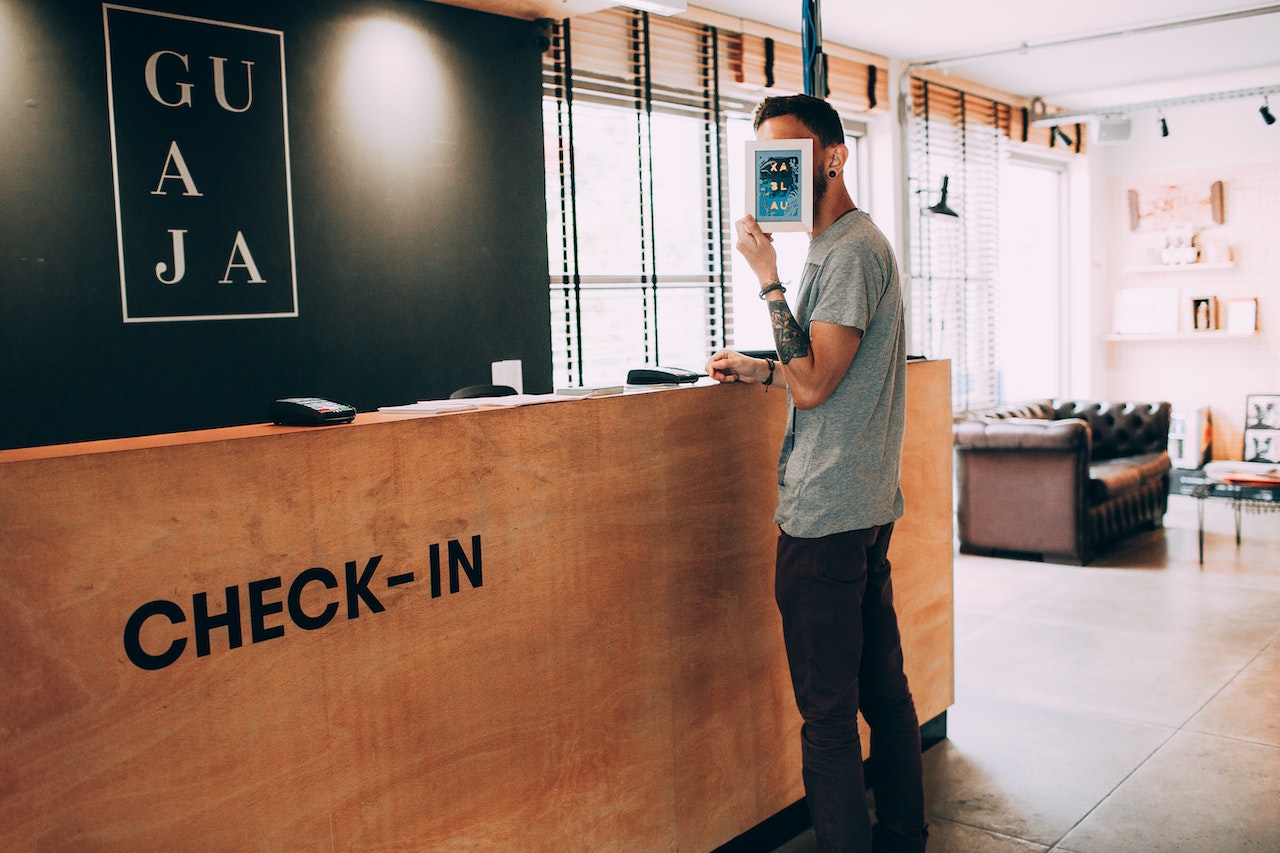In an era where technology is shaping industries and redefining customer experiences, the hospitality sector is no exception.
One technological innovation that has significantly transformed this industry is contactless or
key management systems.
What is Contactless Check-In?
Contactless check-in refers to a system where guests can check into hotels or vacation rentals without any direct physical contact or interaction with the staff. This digital self-service procedure is efficient, secure, and facilitates a seamless arrival experience for the guests.
The Mechanics of Contactless Check-In at Hotels
Contactless check-in is often facilitated via a mobile app or an automated kiosk at the hotel. Guests receive a unique code or a digital key, which they use to access their booked room. It’s a simple process that leverages advanced technology to streamline traditional procedures, reducing the need for front desk assistance.
Contactless check-in benefits align with
digital innovations in hospitality.
The Benefits of Contactless Check-In

Implementing contactless check-in in your property management strategy offers an array of advantages:
Enhanced Guest Convenience: It significantly cuts down the time guests have to spend in queues, allowing them to enjoy their stay right from the moment they step into the property.
Increased Efficiency: This system frees up the staff from the front desk duties, enabling them to focus on other essential aspects of guest experience, thereby increasing operational efficiency.
Promotes Health and Safety: In a post-pandemic world, health safety has become a priority. Contactless check-in eliminates the need for physical interaction, making it a safer alternative for guests and staff alike.
Speculating on
the future of the hospitality industry naturally leads to
innovative tech for vacation rentals.
The Challenges of Contactless Check-In
Despite its numerous advantages, contactless check-in does come with its own set of challenges. It demands a robust and reliable technological infrastructure, which requires a considerable investment. Additionally, the success of this system heavily relies on the guests’ ability to adapt to this digital service.
Contactless Check-In with Airbnb
Airbnb, one of the leading players in the property rental industry, has been quick to adopt this technological innovation. Hosts are now using smart locks, lockboxes, and keypad systems for providing seamless, contactless check-in to their guests. This process not only improves the guest experience but also facilitates an efficient management system for the hosts.
Tips for Making Check-In at Your Property Contactless
To implement a contactless check-in at your property, consider integrating technology such as mobile apps or automated kiosks that provide digital keys.
Also, it’s crucial to provide clear instructions to your guests about the check-in process to ensure a seamless experience.
ID Verification in Contactless Check-In
While contactless check-in enhances convenience, security remains a priority. Modern systems integrate ID verification methods to confirm the guest’s identity. Tools like AI-based guest screening solutions offered by Autohost have proven incredibly effective in ensuring safety and reliability in the check-in process.
Contactless Check-Out: The Departure Experience
Just as with check-in, the check-out process can also be contactless. On the day of departure, guests can simply leave the room, and their digital key will expire. The final bill is automatically sent via email, eliminating the need for a traditional front-desk check-out.
Safety of Contactless Systems

In terms of security, contactless systems use advanced encryption techniques to ensure data privacy and safety. Furthermore, the use of AI-powered screening tools such as Autohost can add an extra layer of security, helping to identify and prevent potential risks.
Predictions about the future of hospitality technology can be linked to
embracing vacation rental innovations.
Broadening the Scope: Contactless Amenities and Services
In addition to check-in and check-out, the concept of contactless service is rapidly expanding to other facets of the hospitality industry.
Imagine accessing the gym, spa, or even ordering room service, all with a few taps on your mobile device. Such integrations not only enhance the guest experience but also streamline the hotel’s operations.
The Role of Mobile Apps in Contactless Hospitality
Mobile applications have become instrumental in enabling contactless services.
By integrating property-specific features and services into a mobile app, guests can enjoy a host of conveniences, right from their smartphones. This includes digital room selection, requesting additional amenities, instant messaging with the front desk, and much more.
Navigating the Technological Landscape: Implementation Challenges
Implementing a contactless service system may seem daunting, especially for smaller properties. The cost and complexity of technology, coupled with the training required to adapt to new systems, can pose significant challenges. However, with a strategic approach, these challenges can be addressed effectively.
Start small by integrating essential features like contactless check-in and gradually build upon these foundational elements. Furthermore, providing regular training sessions for your staff can significantly aid in smooth adaptation and implementation.
Contactless Payment: The Financial Aspect
While we’ve delved deep into the nuances of contactless check-in and check-out, there’s another vital aspect that completes the contactless loop in the hospitality industry—contactless payment systems.
What are Contactless Payments?
Contactless payments are transactions that don’t require any physical contact between the payment device and the point-of-sale terminal. They are often facilitated via NFC (Near Field Communication) technology, allowing guests to tap their smartphones or payment cards near a contactless reader to complete a payment. Sounds pretty seamless, right? Let’s dig into why this matters for property managers and guests alike.
Why Implement Contactless Payments?
Streamlined Transactions
Guests are increasingly looking for quick and efficient experiences, and nothing shouts “efficiency” more than a swift, hassle-free payment process. No fumbling for cash, no waiting for card transactions to process—just a quick tap and you’re good to go.
Enhanced Security
Like contactless check-in systems, these payment methods also integrate advanced security measures, including encryption and tokenization. This ensures that the guests’ sensitive financial information is safe and secure.
Operational Efficiency
From the property manager’s perspective, contactless payments can speed up the billing process and reduce queues at the front desk or in the restaurant, thus optimizing the use of staff resources.
Adaptability in a Post-Pandemic World
In an era still grappling with health and safety concerns, reducing touchpoints is crucial. Contactless payments adhere to this principle, making it a more appealing option for both guests and staff.
Overcoming Challenges
Like any technology, contactless payment systems do have their own hurdles. These may include the costs of implementing new point-of-sale systems and educating staff and guests about the new procedures. However, with a well-thought-out approach that includes proper training and guest communication, these challenges can be easily overcome.
Getting Started with Contactless Payments
To integrate this payment method, start by consulting your payment processor and POS system provider about the necessary hardware and software updates. Moreover, make it a point to educate your staff extensively so they can guide guests through the new payment process effortlessly.
Contactless payments represent yet another step toward a comprehensive, contact-free guest experience. It’s not just a technological fad; it’s a long-term shift in how transactions will occur in the hospitality industry. By embracing this technology alongside other contactless amenities, property managers are better equipped to meet the evolving needs and expectations of modern travelers.
Importance of Personalized Guest Experience
The move towards a digital-first approach doesn’t imply the absence of personalized guest service. In fact, leveraging data from contactless systems, property managers can deliver a more personalized experience.
This can include tailored recommendations for dining and leisure activities, personalized greetings, and customized room settings based on guest preferences. This level of customization can significantly enhance guest satisfaction and loyalty.
The Environmental Impact: A Greener Approach
Contactless services can contribute significantly to the industry’s green initiatives. From eliminating paper-based processes like check-in forms and invoices to optimizing energy usage with smart room controls, these practices are not only tech-forward but also environmentally responsible.
Leveraging Contactless Data for Business Insights
The adoption of contactless services can also provide valuable business insights. The data captured through guest interactions with these digital systems can be analyzed to understand guest behaviors, preferences, and trends. This can aid in strategic decision-making, marketing efforts, and enhancing the overall guest experience.
Automated Hotel Check-In: Your Step-By-Step Guide
If you’re looking to join the movement towards more seamless, contactless guest experiences, implementing
automated hotel check-in is a key starting point. Below is a checklist to guide you through each critical stage of the process.
Planning and Research
Conduct a Needs Analysis: Understand your property’s specific requirements for automation. This may include current occupancy rates, peak times, and staff availability.
Budget Assessment: Crunch the numbers to determine what you can afford to invest in automated check-in technology.
Vendor Research: Look for vendors that specialize in automated hotel check-in solutions. Compare features, reviews, and pricing before making a decision.
Technology Selection
Choose the Right Platform: Decide between a mobile-based system, self-service kiosk, or a hybrid model depending on your property’s needs.
Security Measures: Make sure the platform you choose offers robust security features, including data encryption and secure login methods.
Customization: Opt for a system that allows customization so it can align with your brand and offer personalized guest experiences.
Installation and Integration
Hardware Setup: If you’re using kiosks, ensure they are installed in easily accessible areas like the lobby.
Software Integration: Integrate the check-in system with your existing Property Management System (PMS) for streamlined operations.
Test Run: Conduct thorough tests to ensure the system is running smoothly and is user-friendly.
Staff Training
Initial Training: Train your staff on how to operate the new system and how to guide guests when needed.
Ongoing Support: Establish a system for ongoing technical support and training for new staff members.
Guest Onboarding
Inform Pre-Arrival: Notify guests about the automated check-in option through pre-arrival emails or texts.
In-Hotel Signage: Use signs and visuals in the hotel to guide guests to the automated check-in points.
Instructions: Provide clear, easy-to-follow instructions at the check-in point, and in pre-arrival communications.
Monitoring and Updates
Guest Feedback: Regularly solicit feedback from guests to understand what’s working and what needs improvement.
Software Updates: Keep the system updated with the latest software versions for enhanced security and features.
Periodic Review: Revisit your needs analysis and vendor options periodically to ensure your chosen solution remains the best fit for your property.
By following this checklist, you’ll be well-equipped to implement an automated check-in system that not only meets the demands of modern travelers but also streamlines your operations for improved efficiency and guest satisfaction.
The Future of Contactless Hospitality: Beyond Check-In and Check-Out
The potential of contactless technology in hospitality is vast and extends well beyond check-in and check-out procedures. In the future, we can anticipate even more integrations, such as AI-powered room service, virtual concierge services, and predictive room readiness.
Embracing the Future with Autohost
Autohost’s cutting-edge technology is pushing boundaries in the hospitality industry.
We offer an effective guest screening solution that optimizes contactless check-in and ensures safety and convenience for both guests and property managers. By recognizing the potential of contactless systems and integrating solutions like Autohost, property managers can effectively adapt to the future of hospitality.
The rise of contactless check-in represents an exciting advancement in the hospitality sector. It’s about embracing change, driving efficiency, enhancing guest experience, and above all, leveraging technology to meet the evolving demands of the industry. While challenges exist, the benefits are compelling, and with the right approach and tools like Autohost, you can navigate these hurdles and embrace the future of hospitality.
 Implementing contactless check-in in your property management strategy offers an array of advantages:
Enhanced Guest Convenience: It significantly cuts down the time guests have to spend in queues, allowing them to enjoy their stay right from the moment they step into the property.
Increased Efficiency: This system frees up the staff from the front desk duties, enabling them to focus on other essential aspects of guest experience, thereby increasing operational efficiency.
Promotes Health and Safety: In a post-pandemic world, health safety has become a priority. Contactless check-in eliminates the need for physical interaction, making it a safer alternative for guests and staff alike.
Speculating on the future of the hospitality industry naturally leads to innovative tech for vacation rentals.
Implementing contactless check-in in your property management strategy offers an array of advantages:
Enhanced Guest Convenience: It significantly cuts down the time guests have to spend in queues, allowing them to enjoy their stay right from the moment they step into the property.
Increased Efficiency: This system frees up the staff from the front desk duties, enabling them to focus on other essential aspects of guest experience, thereby increasing operational efficiency.
Promotes Health and Safety: In a post-pandemic world, health safety has become a priority. Contactless check-in eliminates the need for physical interaction, making it a safer alternative for guests and staff alike.
Speculating on the future of the hospitality industry naturally leads to innovative tech for vacation rentals.
 In terms of security, contactless systems use advanced encryption techniques to ensure data privacy and safety. Furthermore, the use of AI-powered screening tools such as Autohost can add an extra layer of security, helping to identify and prevent potential risks.
Predictions about the future of hospitality technology can be linked to embracing vacation rental innovations.
In terms of security, contactless systems use advanced encryption techniques to ensure data privacy and safety. Furthermore, the use of AI-powered screening tools such as Autohost can add an extra layer of security, helping to identify and prevent potential risks.
Predictions about the future of hospitality technology can be linked to embracing vacation rental innovations.
 Implementing contactless check-in in your property management strategy offers an array of advantages:
Enhanced Guest Convenience: It significantly cuts down the time guests have to spend in queues, allowing them to enjoy their stay right from the moment they step into the property.
Increased Efficiency: This system frees up the staff from the front desk duties, enabling them to focus on other essential aspects of guest experience, thereby increasing operational efficiency.
Promotes Health and Safety: In a post-pandemic world, health safety has become a priority. Contactless check-in eliminates the need for physical interaction, making it a safer alternative for guests and staff alike.
Speculating on the future of the hospitality industry naturally leads to innovative tech for vacation rentals.
Implementing contactless check-in in your property management strategy offers an array of advantages:
Enhanced Guest Convenience: It significantly cuts down the time guests have to spend in queues, allowing them to enjoy their stay right from the moment they step into the property.
Increased Efficiency: This system frees up the staff from the front desk duties, enabling them to focus on other essential aspects of guest experience, thereby increasing operational efficiency.
Promotes Health and Safety: In a post-pandemic world, health safety has become a priority. Contactless check-in eliminates the need for physical interaction, making it a safer alternative for guests and staff alike.
Speculating on the future of the hospitality industry naturally leads to innovative tech for vacation rentals.
 In terms of security, contactless systems use advanced encryption techniques to ensure data privacy and safety. Furthermore, the use of AI-powered screening tools such as Autohost can add an extra layer of security, helping to identify and prevent potential risks.
Predictions about the future of hospitality technology can be linked to embracing vacation rental innovations.
In terms of security, contactless systems use advanced encryption techniques to ensure data privacy and safety. Furthermore, the use of AI-powered screening tools such as Autohost can add an extra layer of security, helping to identify and prevent potential risks.
Predictions about the future of hospitality technology can be linked to embracing vacation rental innovations.





